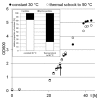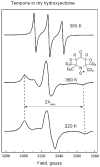Glass-forming property of hydroxyectoine is the cause of its superior function as a desiccation protectant
- PMID: 24772110
- PMCID: PMC3983491
- DOI: 10.3389/fmicb.2014.00150
Glass-forming property of hydroxyectoine is the cause of its superior function as a desiccation protectant
Abstract
We were able to demonstrate that hydroxyectoine, in contrast to ectoine, is a good glass-forming compound. Fourier transform infrared and spin label electron spin resonance studies of dry ectoine and hydroxyectoine have shown that the superior glass-forming properties of hydroxyectoine result from stronger intermolecular H-bonds with the OH group of hydroxyectoine. Spin probe experiments have also shown that better molecular immobilization in dry hydroxyectoine provides better redox stability of the molecules embedded in this dry matrix. With a glass transition temperature of 87°C (vs. 47°C for ectoine) hydroxyectoine displays remarkable desiccation protection properties, on a par with sucrose and trehalose. This explains its accumulation in response to increased salinity and elevated temperature by halophiles such as Halomonas elongata and its successful application in ``anhydrobiotic engineering'' of both enzymes and whole cells.
Keywords: ESR; FTIR; desiccation; enzyme stabilization; glass transition temperature; hydroxyectoine.
Figures












Similar articles
-
Microbial production of ectoine and hydroxyectoine as high-value chemicals.Microb Cell Fact. 2021 Mar 26;20(1):76. doi: 10.1186/s12934-021-01567-6. Microb Cell Fact. 2021. PMID: 33771157 Free PMC article. Review.
-
Synthesis and release of the bacterial compatible solute 5-hydroxyectoine in Hansenula polymorpha.J Biotechnol. 2013 Aug 20;167(2):85-93. doi: 10.1016/j.jbiotec.2013.02.005. Epub 2013 Mar 4. J Biotechnol. 2013. PMID: 23467000
-
The ectD gene, which is involved in the synthesis of the compatible solute hydroxyectoine, is essential for thermoprotection of the halophilic bacterium Chromohalobacter salexigens.J Bacteriol. 2006 Jun;188(11):3774-84. doi: 10.1128/JB.00136-06. J Bacteriol. 2006. PMID: 16707670 Free PMC article.
-
High survival and stability rates of Escherichia coli dried in hydroxyectoine.FEMS Microbiol Lett. 2004 Apr 15;233(2):347-52. doi: 10.1016/j.femsle.2004.03.005. FEMS Microbiol Lett. 2004. PMID: 15063506
-
Role of the Extremolytes Ectoine and Hydroxyectoine as Stress Protectants and Nutrients: Genetics, Phylogenomics, Biochemistry, and Structural Analysis.Genes (Basel). 2018 Mar 22;9(4):177. doi: 10.3390/genes9040177. Genes (Basel). 2018. PMID: 29565833 Free PMC article. Review.
Cited by
-
Biosynthesis of the Stress-Protectant and Chemical Chaperon Ectoine: Biochemistry of the Transaminase EctB.Front Microbiol. 2019 Dec 10;10:2811. doi: 10.3389/fmicb.2019.02811. eCollection 2019. Front Microbiol. 2019. PMID: 31921013 Free PMC article.
-
Formulating bacterial endophyte: Pre-conditioning of cells and the encapsulation in amidated pectin beads.Biotechnol Rep (Amst). 2020 Apr 28;26:e00463. doi: 10.1016/j.btre.2020.e00463. eCollection 2020 Jun. Biotechnol Rep (Amst). 2020. PMID: 32405468 Free PMC article.
-
Rational engineering of Halomonas salifodinae to enhance hydroxyectoine production under lower-salt conditions.Appl Microbiol Biotechnol. 2024 May 31;108(1):353. doi: 10.1007/s00253-024-13197-0. Appl Microbiol Biotechnol. 2024. PMID: 38819481 Free PMC article.
-
Degradation of the microbial stress protectants and chemical chaperones ectoine and hydroxyectoine by a bacterial hydrolase-deacetylase complex.J Biol Chem. 2020 Jul 3;295(27):9087-9104. doi: 10.1074/jbc.RA120.012722. Epub 2020 May 13. J Biol Chem. 2020. PMID: 32404365 Free PMC article.
-
Overproduction, crystallization and X-ray diffraction data analysis of ectoine synthase from the cold-adapted marine bacterium Sphingopyxis alaskensis.Acta Crystallogr F Struct Biol Commun. 2015 Aug;71(Pt 8):1027-32. doi: 10.1107/S2053230X15011115. Epub 2015 Jul 28. Acta Crystallogr F Struct Biol Commun. 2015. PMID: 26249694 Free PMC article.
References
LinkOut - more resources
Full Text Sources
Other Literature Sources
Miscellaneous

